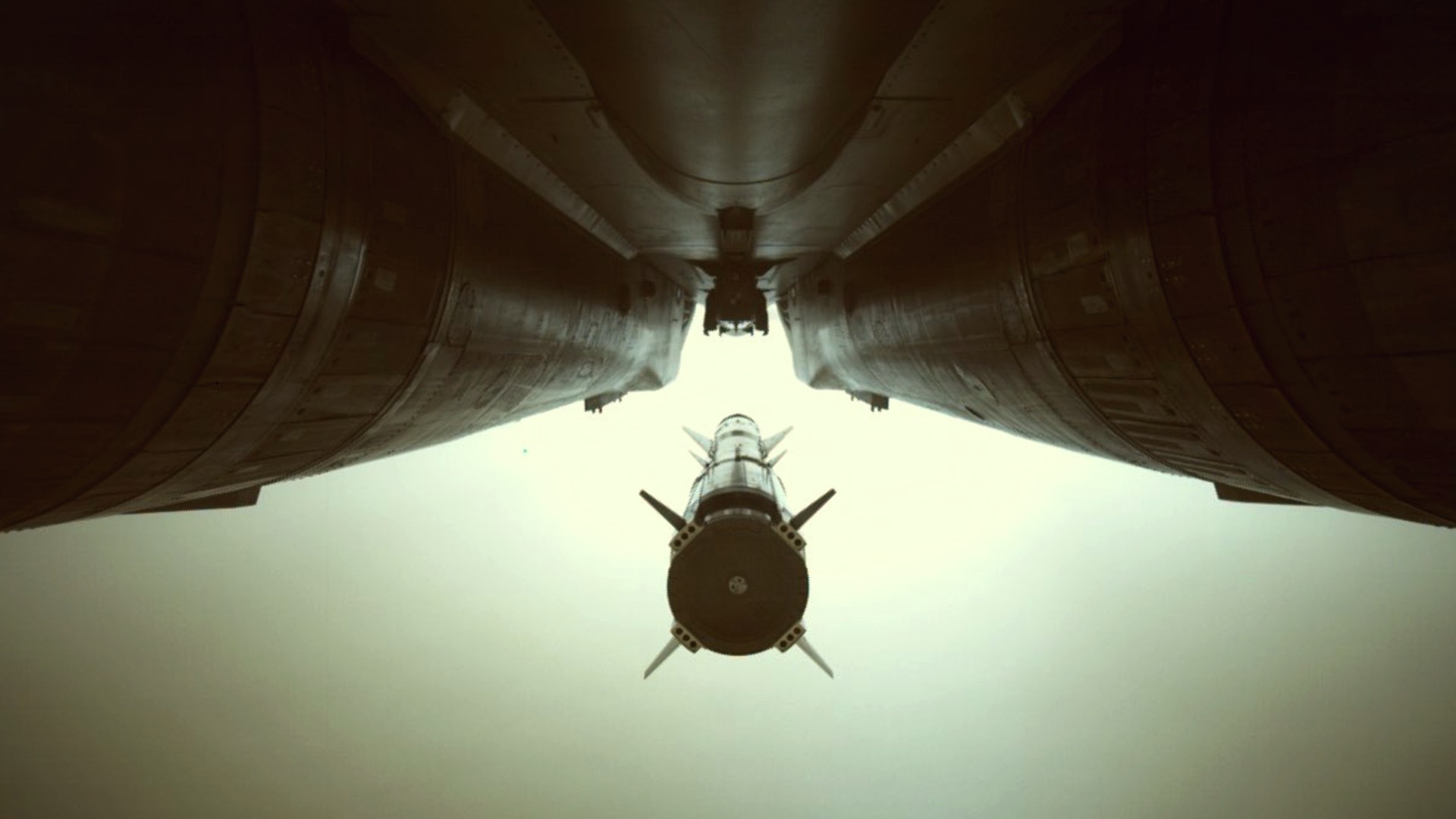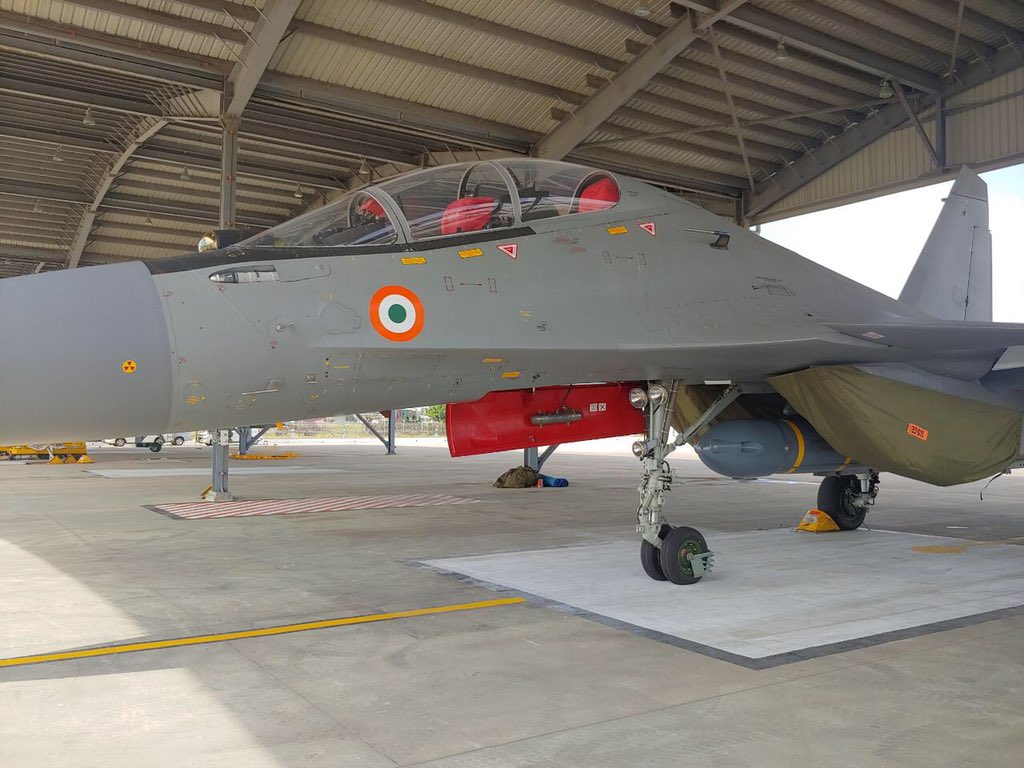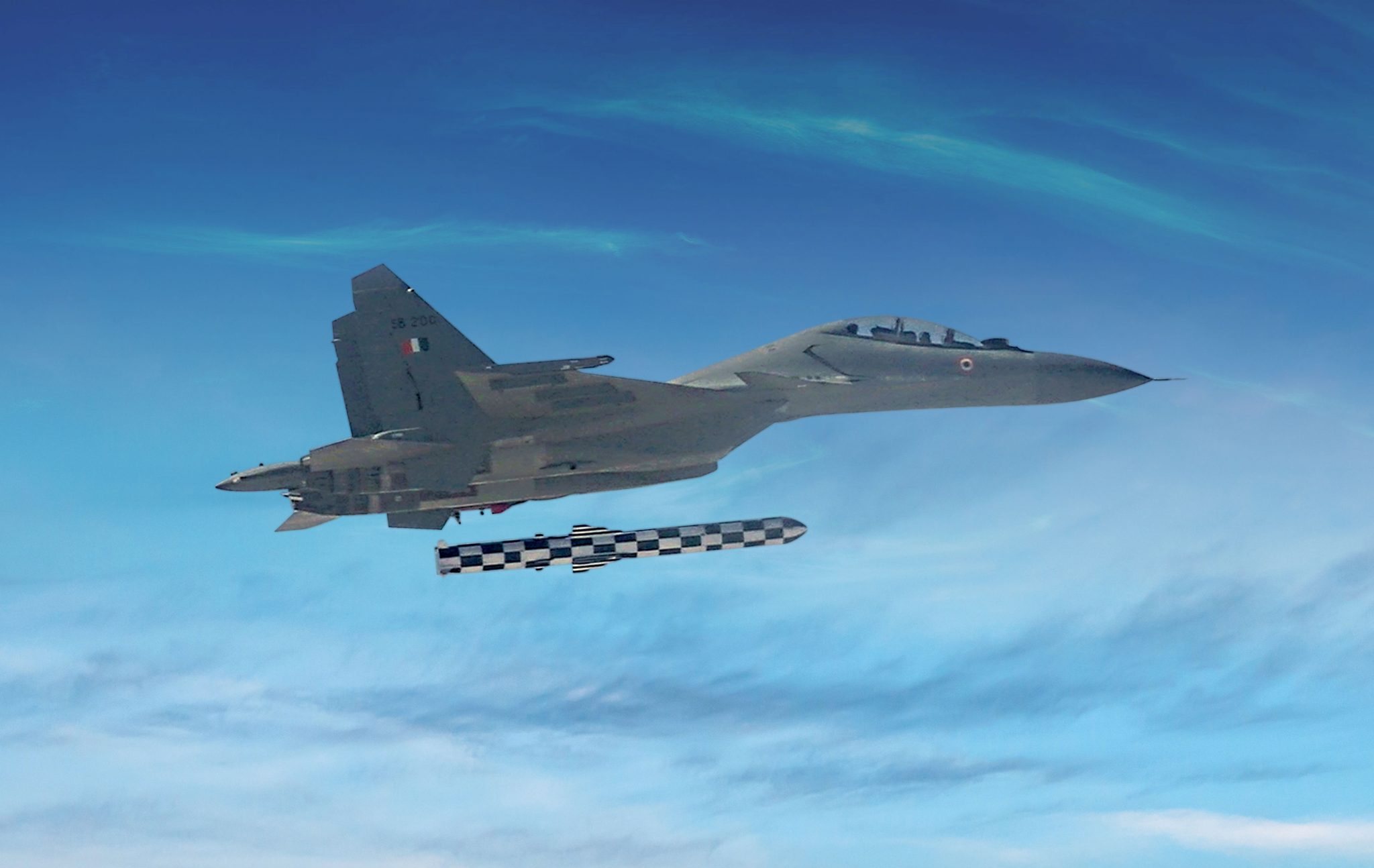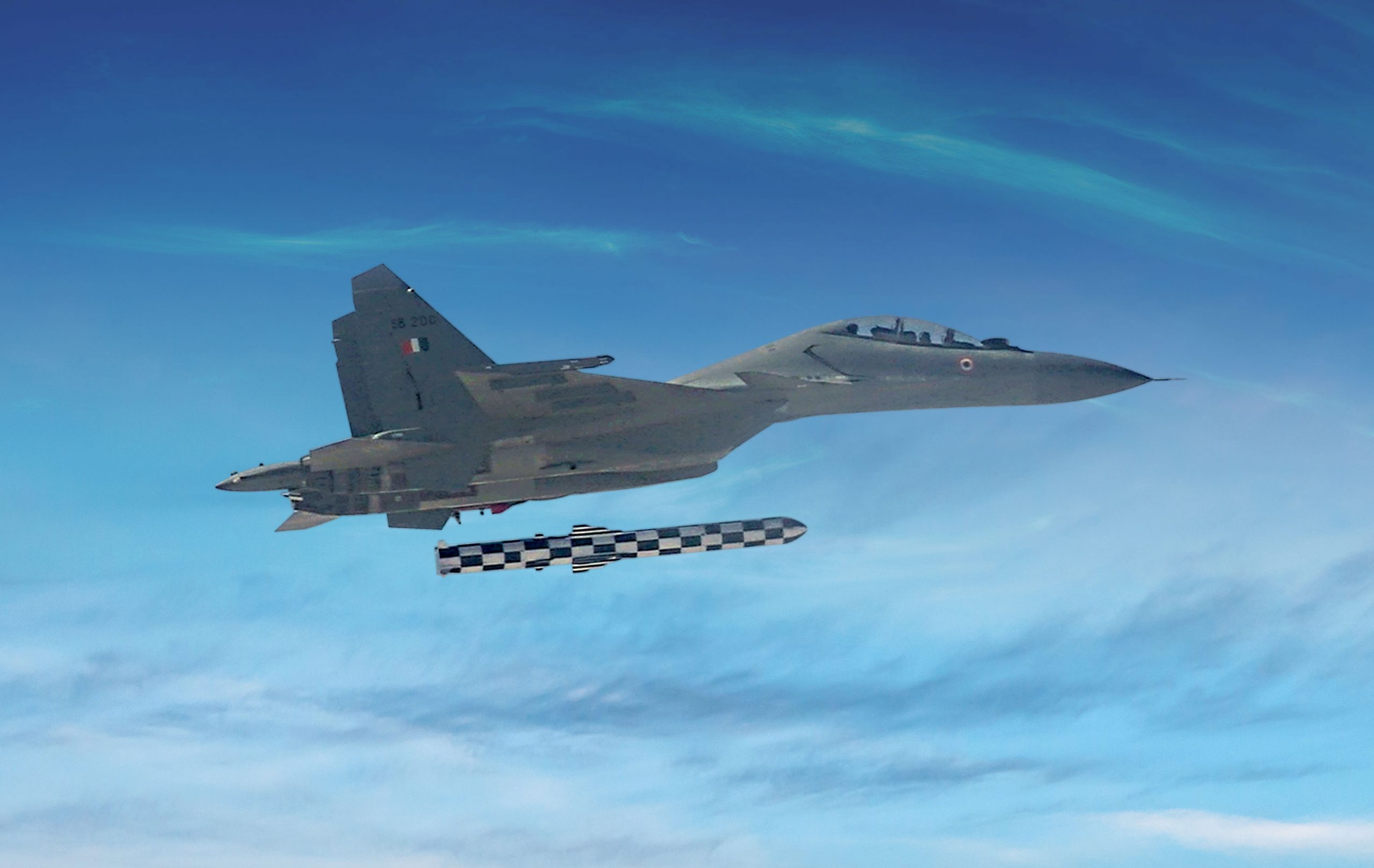BrahMos Cruise Missile
- Thread starter nitesh
- Start date
More options
Who Replied?WolfPack86
New Member
- Joined
- Oct 20, 2015
- Messages
- 10,571
- Likes
- 16,993
Amidst Border Bloodshed, Air-Launched BrahMos Cleared For Combat

At a time when an escalating 40-day border standoff has led to a savage clash with multiple casualties in Indian and Chinese army units in Ladakh’s Galwan Valley, the Indian military has just welcomed a new weapon into its operational arsenal. While the brutal violence that exploded on a lonely ridge in eastern Ladakh on the night of June 15 saw the use of Chinese nail-studded clubs, barbed-wire wrapped rods and rocks to inflict medieval-style death and injuries, over 3,500 km away at an air base in South India, a crucial weapon was quietly cleared into combat service.
The Indian Air Force can now fly Su-30 MKI combat missions with the BrahMos-A air-launched supersonic cruise missile. In a final milestone that clears the decks for use in operations, the missile system has just received ‘fleet release clearance’ from the Centre for Military Airworthiness and Certification (CEMILAC), DRDO, the government’s gatekeeper that provides a final stamp on flying equipment before military use.
The first BrahMos-armed Su-30 MKI jets were inducted into the Indian Air Force’s 222 Squadron ‘Tigersharks’ in January this year at the Thanjavur air force station in Tamil Nadu.

A BrahMos Corp. official told Livefist, “The issuance of fleet release clearance certification has paved the way for pilots of Indian Air Force (IAF) squadrons to use the missile during combat missions. In a meeting held through video conferencing on June 10, 2020, which was attended by all major stakeholders, including DRDO, BrahMos Aerospace, ASTE, SDI and Air HQs, the certification was issued to the BRAHMOS airborne weapon. This has led to the successful culmination of the BRAHMOS-Su-30MKI weapon-platform integration program.”
Livefist had this detailed interaction with Praveen Pathak, BrahMos Corp’s Chief General Manager (Mkt. Promotion & Export) last year in Russia ahead of the BrahMos-A’s entry into service:
While it isn’t specifically linked to the India-China border standoff, combat clearance to the BrahMos-A comes at a time when China has openly mobilised air and ground assets to support an aggressive posture along the Line of Actual Control in Ladakh, with visible motor pools, armour support and combat aircraft at freshly spruced up bases not far from Ladakh. The BrahMos-A arms a handful of modified Su-30 MKIs at present, with plans for more. Non-BrahMos IAF Su-30s are regularly positioned on detachment at bases that include Srinagar and Leh, with combat air patrols in the area a matter of routine.

The BrahMos-A has required extensive modifications on the Su-30 MKI fuselage, allowing for a single missile to be carried underslung on a specially engineered belly pylon. BrahMos Corp. is also developing a smaller, lighter BrahMos NG missile. Livefist reported three years ago that developers are looking to offer the variant for more of the IAF’s fighters.
Crucially, In the last few years, developers have also been allowed to expand the BrahMos’s range. So far restricted to just under 300 km by the Missile Technology Control Regime (MTCR), India becoming a signatory in 2017 has seen BrahMos tests at expanded range, with a ‘final’ BrahMos likely to be fixed at a range of 900 km.

 www.livefistdefence.com
www.livefistdefence.com

At a time when an escalating 40-day border standoff has led to a savage clash with multiple casualties in Indian and Chinese army units in Ladakh’s Galwan Valley, the Indian military has just welcomed a new weapon into its operational arsenal. While the brutal violence that exploded on a lonely ridge in eastern Ladakh on the night of June 15 saw the use of Chinese nail-studded clubs, barbed-wire wrapped rods and rocks to inflict medieval-style death and injuries, over 3,500 km away at an air base in South India, a crucial weapon was quietly cleared into combat service.
The Indian Air Force can now fly Su-30 MKI combat missions with the BrahMos-A air-launched supersonic cruise missile. In a final milestone that clears the decks for use in operations, the missile system has just received ‘fleet release clearance’ from the Centre for Military Airworthiness and Certification (CEMILAC), DRDO, the government’s gatekeeper that provides a final stamp on flying equipment before military use.
The first BrahMos-armed Su-30 MKI jets were inducted into the Indian Air Force’s 222 Squadron ‘Tigersharks’ in January this year at the Thanjavur air force station in Tamil Nadu.

A BrahMos Corp. official told Livefist, “The issuance of fleet release clearance certification has paved the way for pilots of Indian Air Force (IAF) squadrons to use the missile during combat missions. In a meeting held through video conferencing on June 10, 2020, which was attended by all major stakeholders, including DRDO, BrahMos Aerospace, ASTE, SDI and Air HQs, the certification was issued to the BRAHMOS airborne weapon. This has led to the successful culmination of the BRAHMOS-Su-30MKI weapon-platform integration program.”
Livefist had this detailed interaction with Praveen Pathak, BrahMos Corp’s Chief General Manager (Mkt. Promotion & Export) last year in Russia ahead of the BrahMos-A’s entry into service:
While it isn’t specifically linked to the India-China border standoff, combat clearance to the BrahMos-A comes at a time when China has openly mobilised air and ground assets to support an aggressive posture along the Line of Actual Control in Ladakh, with visible motor pools, armour support and combat aircraft at freshly spruced up bases not far from Ladakh. The BrahMos-A arms a handful of modified Su-30 MKIs at present, with plans for more. Non-BrahMos IAF Su-30s are regularly positioned on detachment at bases that include Srinagar and Leh, with combat air patrols in the area a matter of routine.

The BrahMos-A has required extensive modifications on the Su-30 MKI fuselage, allowing for a single missile to be carried underslung on a specially engineered belly pylon. BrahMos Corp. is also developing a smaller, lighter BrahMos NG missile. Livefist reported three years ago that developers are looking to offer the variant for more of the IAF’s fighters.
Crucially, In the last few years, developers have also been allowed to expand the BrahMos’s range. So far restricted to just under 300 km by the Missile Technology Control Regime (MTCR), India becoming a signatory in 2017 has seen BrahMos tests at expanded range, with a ‘final’ BrahMos likely to be fixed at a range of 900 km.

Amidst Border Heat, Air-Launched BrahMos Cleared For Combat
At a time when an escalating 40-day border standoff has led to a savage clash with multiple casualties in Indian and Chinese army units in Ladakh's Galwan Valley, the Indian military has just welcomed a new weapon into its operational arsenal. While the brutal violence that exploded on a lonely…
WolfPack86
New Member
- Joined
- Oct 20, 2015
- Messages
- 10,571
- Likes
- 16,993
216 Air BRAHM0S order | Apache in Leh | Vertical launch Astra for Indian Navy
Karthi
New Member
- Joined
- Jul 15, 2018
- Messages
- 2,214
- Likes
- 17,755
Russian patent by DRDO on BrahMos road-mobile TEL.
The invention relates to a mobile missile launcher system, a method for holding a rocket, a method for preventing linear movement of a rocket, and a method for launching a rocket. The mobile missile launcher system comprises a vehicle (14) with a chassis adapted to transport a launcher; installation frame (16), which is a diagonal-truss structure mounted on the chassis of the car; several sliding mechanisms installed in the rear section of the installation frame (16); several containers (43) with missiles enclosed in them (11) mounted on a beam structure (22); several containers (42) that enclose the indicated containers (43) and which are connected with saddle lodges (32, 34) for linear movement; several starting supports (27), adjacent to the rear ends of the containers (43) and made with the possibility of linear movement to transfer reactive forces from missiles (11) to the ground. The mobility of the launch complex is ensured, the speed of its deployment, the risk of detecting the complex is reduced. 4 n. and 14 z.p. f-ly, 25 ill.


 yandex.ru
yandex.ru
The invention relates to a mobile missile launcher system, a method for holding a rocket, a method for preventing linear movement of a rocket, and a method for launching a rocket. The mobile missile launcher system comprises a vehicle (14) with a chassis adapted to transport a launcher; installation frame (16), which is a diagonal-truss structure mounted on the chassis of the car; several sliding mechanisms installed in the rear section of the installation frame (16); several containers (43) with missiles enclosed in them (11) mounted on a beam structure (22); several containers (42) that enclose the indicated containers (43) and which are connected with saddle lodges (32, 34) for linear movement; several starting supports (27), adjacent to the rear ends of the containers (43) and made with the possibility of linear movement to transfer reactive forces from missiles (11) to the ground. The mobility of the launch complex is ensured, the speed of its deployment, the risk of detecting the complex is reduced. 4 n. and 14 z.p. f-ly, 25 ill.
RU2493529C2 - МОБИЛЬНАЯ РАКЕТНАЯ ПУСКОВАЯ УСТАНОВКА И СПОСОБ ЗАПУСКА РАКЕТЫ - Яндекс.Патенты
Патент RU2493529C2: Изобретение относится к системе мобильной ракетной пусковой установки, способу удержания ракеты, способу предотвращения линейного перемещения ракеты и способу запуска ракеты. Система мобильной ракетной пусковой установки содержит автомобиль (14) с шасси, приспособленный для...
Russian patent implemented by DRDO.^Excuse my slow wittedness here. is this a Russian patent/innovation that DRDO is implementing, or a DRDO patent/innovation that is recognised by the Russians.
- Joined
- Jan 14, 2020
- Messages
- 9,609
- Likes
- 84,139
except engine every thing has been indigenised.Thanks, are there any Indian innovations that have gone into Brahmos. Avionics, software, control systems, metallic components..
Random titbit
2016 : 1889 Missile Regiment (Brahmos) appears for first time in republic day parade
Formation Sign is of 42nd Artillery Division under 1 Corps (Mathura)

2017 South Western Command / 1 Corps (Mathura) test Brahmos in Andaman
2019: 1889 Missile Regiment appears at Kolkata Republic Day under formation sign of Eastern Army Command

May 2019 : Eastern Command conducts test
Me thinks that the 1889 Brahmos Regiment was/is loaned or transferred from South Western Command/ 1 Corps to Eastern Command /17 Corps
Also note that the 2017 test was of Block 3 which was needed in mountains.
The 1 Strike Corps which operates in plains of Punjab, Rajasthan, Gujrat didnt need this capability at all.
The eastern command does need that ability.
2016 : 1889 Missile Regiment (Brahmos) appears for first time in republic day parade
Formation Sign is of 42nd Artillery Division under 1 Corps (Mathura)
2017 South Western Command / 1 Corps (Mathura) test Brahmos in Andaman
2019: 1889 Missile Regiment appears at Kolkata Republic Day under formation sign of Eastern Army Command

May 2019 : Eastern Command conducts test
Me thinks that the 1889 Brahmos Regiment was/is loaned or transferred from South Western Command/ 1 Corps to Eastern Command /17 Corps
Also note that the 2017 test was of Block 3 which was needed in mountains.
The 1 Strike Corps which operates in plains of Punjab, Rajasthan, Gujrat didnt need this capability at all.
The eastern command does need that ability.
Last edited:
Karthi
New Member
- Joined
- Jul 15, 2018
- Messages
- 2,214
- Likes
- 17,755
The DRDO has stopped testing the BRAHMOS ER (BRAHMOS ER) which has increased its range of attack, as the corona infection is currently intensifying in the country.
India is currently a member of the Missile Technology Control Regime (MTCR) and can now increase the range of joint missiles.
The 290 km range of the BrahMas missile has been increased to about 400 km. The 500 km range has also been upgraded to 600 km.
The Brahmos, which has a Ramjet engine, can now carry more fuel and can easily fly at Mach 3 or 4 speeds, which means it can fly at speeds of 3600 to 4900 km / h.
It was only after India joined the Missile Technology Control System that the range of the Brahmos missile was increased to about 800 km. It was then decided to increase it to 400 km and after the success of the test to upgrade to a distance of 800 km.
The BrahMas missile was first tested in 2001 and has undergone various upgrades.
Indian military planners hope that in the future, BrahMas' capabilities will not be compromised by sophisticated technology, long-range attack capability and high speed.
Sahilrana5569
New Member
- Joined
- Aug 13, 2020
- Messages
- 1
- Likes
- 0
Range may be not rhe the problem the government just adjusts it as per the MTCR guidelines.While I agree that in India's case a longer range (800 kms) Brahmos may be more useful in the short/medium term, it is also inevitable that air defense systems will mature to intercept supersonic cruise missiles like Brahmos easily. As such hypersonic cruise missiles (despite paying the drag cost) may be a necessity in the future.
WolfPack86
New Member
- Joined
- Oct 20, 2015
- Messages
- 10,571
- Likes
- 16,993
BrahMos Says Got Permission From Russia, India to Export Missiles to Third Countries
MOSCOW (Sputnik) - BrahMos Aerospace, a joint Russian-Indian developer of the BRAHMOS supersonic cruise missiles, said on Monday it got greenlighted by the governments of Russia and India to export the missile to third countries.
"A lot of countries have shown great interest in [purchasing the missiles of] BrahMos. We are now working with our Russian colleagues. We have already received [export] permits from Russia and the Indian government, and we really hope that as soon as the pandemic is over, we will be able to act on it," BrahMos Chief General Manager Praveen Pathak said on the sidelines of the Russian-hosted Army 2020 forum.
BrahMos Aerospace was established in 1998 as a joint venture of Russian rocket and missile developer NPO Mashinostroyeniya and India's Defence Research and Development Organisation.
MOSCOW (Sputnik) - BrahMos Aerospace, a joint Russian-Indian developer of the BRAHMOS supersonic cruise missiles, said on Monday it got greenlighted by the governments of Russia and India to export the missile to third countries.
"A lot of countries have shown great interest in [purchasing the missiles of] BrahMos. We are now working with our Russian colleagues. We have already received [export] permits from Russia and the Indian government, and we really hope that as soon as the pandemic is over, we will be able to act on it," BrahMos Chief General Manager Praveen Pathak said on the sidelines of the Russian-hosted Army 2020 forum.
BrahMos Aerospace was established in 1998 as a joint venture of Russian rocket and missile developer NPO Mashinostroyeniya and India's Defence Research and Development Organisation.
WolfPack86
New Member
- Joined
- Oct 20, 2015
- Messages
- 10,571
- Likes
- 16,993
Tests of increased-range BrahMos cruise missiles set for 2020
Tests of several modifications of the Russian-Indian BrahMos cruise missiles with extended range are planned for 2020, Tactical Missiles Corporation (TMC) JSC CEO Boris Obnosov told TASS Monday. “Tests of BrahMos modifications with increased range planned for this year,” he said at the Army-2020 international military forum. Earlier this summer, BrahMos’s air-based modification (BrahMos-A) was successfully certified in India, Obnosov noted. “Quite recently, on June 10, the air-based supersonic cruise missile obtained its first permission for use, provided by India’s CEMILAC certification agency. All specifications for the Indian Air Force have been confirmed. The BrahMos has become the first Indian aviation missile to obtain this permission,” the TMC CEO said. According to Obnosov, the BrahMos-A air-based cruise missile will significantly increase capabilities of the Indian Air Force. “The BrahMos’s launch range to the target is 300 km, while Su-30MKI jet fighter’s range with air refueling is over 3,000 km – together, this provided [Indian] Air Force with a huge advantage in their actions in the Indian Ocean zone,” Obnosov noted. The CEO highly praised the work of the Russian-Indian BrahMos Aerospace joint venture. “This rapidly developing joint venture is one of the best examples of military-technical cooperation,” he underscored.
Tests of several modifications of the Russian-Indian BrahMos cruise missiles with extended range are planned for 2020, Tactical Missiles Corporation (TMC) JSC CEO Boris Obnosov told TASS Monday. “Tests of BrahMos modifications with increased range planned for this year,” he said at the Army-2020 international military forum. Earlier this summer, BrahMos’s air-based modification (BrahMos-A) was successfully certified in India, Obnosov noted. “Quite recently, on June 10, the air-based supersonic cruise missile obtained its first permission for use, provided by India’s CEMILAC certification agency. All specifications for the Indian Air Force have been confirmed. The BrahMos has become the first Indian aviation missile to obtain this permission,” the TMC CEO said. According to Obnosov, the BrahMos-A air-based cruise missile will significantly increase capabilities of the Indian Air Force. “The BrahMos’s launch range to the target is 300 km, while Su-30MKI jet fighter’s range with air refueling is over 3,000 km – together, this provided [Indian] Air Force with a huge advantage in their actions in the Indian Ocean zone,” Obnosov noted. The CEO highly praised the work of the Russian-Indian BrahMos Aerospace joint venture. “This rapidly developing joint venture is one of the best examples of military-technical cooperation,” he underscored.
WolfPack86
New Member
- Joined
- Oct 20, 2015
- Messages
- 10,571
- Likes
- 16,993
India plans Two Hypersonic BrahMos-2K version of the cruise missile
The BrahMos Aerospace joint venture Russian NPO Mashinostroyenia has revealed new plans to develop the next generation of BrahMos-2K which will supersede current BrahMos Supersonic cruise missiles with better speed and range. BrahMos-2K will be developed in Two stages it means it will have tow versions to start with. In the first stage, Mach 5 capable BrahMos-2K will be developed by 2024 and in the Second Stage, a Mach 7 Capable BrahMos-2K will be developed by 2027 onwards. The Second stage liquid-fueled, air-breathing ramjet engine is used to sustain Mach 3 speed in the Cruise phase after first stage solid Propellant booster separation which is used for launch and then attain Mach 1 speed. According to informed sources close to idrw.org, BrahMos Aerospace plans to upgrade the Second stage liquid-fueled, air-breathing ramjet engine for Mach 5 capable performance in the cruise phase for which it already has Transfer of Technology from Russia. BrahMos Aerospace already carried out a series of lab tests at the speed of Mach 6.5 as informed to idrw.org but speed might be curtailed just above Mach 5 which Technically makes it a Hypersonic Cruise missile when it is ready for testing in 2024. Mach 7 capable BrahMos-2K likely will feature a new scramjet engine in which India is negotiating with Russia. An Export scramjet engine derivative might come from what has been used on the Russian 3M22 Zircon a scramjet-powered maneuvering anti-ship hypersonic cruise missile currently in testing by Russia. The new scramjet engine will have Mach 7 speed which can be further upgraded till Mach 9. BrahMos-2K is expected to have a 500km range in Low-level Profile and will have a range of 800km in a High-level Profile. Indian Tri-Service will not be replacing BrahMos with BrahMos-2K nor it will be procured at the same levels due to the expected high price of the missile system but it will be seen as a welcome boost in the Offensive cruise missile technology for the country. BrahMos-2K will be available for Frontline Warships and in Land-Based Truck-mounted Variants for both Land and Anti-Ship Target Profiles but Air-Launched variant like BrahMos-A might not happen due to weight concerns but instead BrahMos Aerospace will be developing a BrahMos-NG (Next Generation ) Mach 3 Capable Air-Launched Cruise missile which will be smaller and lighter than BrahMos-A and will be made available for all fighter jets operated by IAF and unlike BrahMos-A will not be limited to specially modified Sukhoi-30MKI fleet. BrahMos Aerospace plans to increase the range of current generation BrahMos to 800 km. BrahMos already has demonstrated a new improved range of from 290 km in recent tests but the ultimate goal is to achieve an 800km range by end of this year without sacrificing on speed.
The BrahMos Aerospace joint venture Russian NPO Mashinostroyenia has revealed new plans to develop the next generation of BrahMos-2K which will supersede current BrahMos Supersonic cruise missiles with better speed and range. BrahMos-2K will be developed in Two stages it means it will have tow versions to start with. In the first stage, Mach 5 capable BrahMos-2K will be developed by 2024 and in the Second Stage, a Mach 7 Capable BrahMos-2K will be developed by 2027 onwards. The Second stage liquid-fueled, air-breathing ramjet engine is used to sustain Mach 3 speed in the Cruise phase after first stage solid Propellant booster separation which is used for launch and then attain Mach 1 speed. According to informed sources close to idrw.org, BrahMos Aerospace plans to upgrade the Second stage liquid-fueled, air-breathing ramjet engine for Mach 5 capable performance in the cruise phase for which it already has Transfer of Technology from Russia. BrahMos Aerospace already carried out a series of lab tests at the speed of Mach 6.5 as informed to idrw.org but speed might be curtailed just above Mach 5 which Technically makes it a Hypersonic Cruise missile when it is ready for testing in 2024. Mach 7 capable BrahMos-2K likely will feature a new scramjet engine in which India is negotiating with Russia. An Export scramjet engine derivative might come from what has been used on the Russian 3M22 Zircon a scramjet-powered maneuvering anti-ship hypersonic cruise missile currently in testing by Russia. The new scramjet engine will have Mach 7 speed which can be further upgraded till Mach 9. BrahMos-2K is expected to have a 500km range in Low-level Profile and will have a range of 800km in a High-level Profile. Indian Tri-Service will not be replacing BrahMos with BrahMos-2K nor it will be procured at the same levels due to the expected high price of the missile system but it will be seen as a welcome boost in the Offensive cruise missile technology for the country. BrahMos-2K will be available for Frontline Warships and in Land-Based Truck-mounted Variants for both Land and Anti-Ship Target Profiles but Air-Launched variant like BrahMos-A might not happen due to weight concerns but instead BrahMos Aerospace will be developing a BrahMos-NG (Next Generation ) Mach 3 Capable Air-Launched Cruise missile which will be smaller and lighter than BrahMos-A and will be made available for all fighter jets operated by IAF and unlike BrahMos-A will not be limited to specially modified Sukhoi-30MKI fleet. BrahMos Aerospace plans to increase the range of current generation BrahMos to 800 km. BrahMos already has demonstrated a new improved range of from 290 km in recent tests but the ultimate goal is to achieve an 800km range by end of this year without sacrificing on speed.
WolfPack86
New Member
- Joined
- Oct 20, 2015
- Messages
- 10,571
- Likes
- 16,993
Russia, India to Launch New Brahmos Missile Capable of Downing Aircraft With AWACS System by 2024
The new missile will be used for destroying major aerial targets, while the previous versions were only capable of destroying targets on the ground or at sea. Russia and India have adopted a plan for their joint BrahMos project, meant to create a new cruise missile capable of downing aircraft equipped with AWACS systems (an advanced Airborne early warning and control). According to the Russian director of the venture, Alexander Maksichev, the missile will be ready for launch by 2024. He noted that it will have different target-seeking equipment but will use the same platform. He previously said that the Indian light-weight fighter Tejas will be used as a carrier for the missile. The BrahMos venture was established by Moscow and New Delhi in 1998 and develops hypersonic missiles —naval-, underwater-, shore-, and air-based. It has recently faced a major surge in demand, with an additional $1 billion increase in orders in six months since the beginning of the year despite the coronavirus pandemic.
The new missile will be used for destroying major aerial targets, while the previous versions were only capable of destroying targets on the ground or at sea. Russia and India have adopted a plan for their joint BrahMos project, meant to create a new cruise missile capable of downing aircraft equipped with AWACS systems (an advanced Airborne early warning and control). According to the Russian director of the venture, Alexander Maksichev, the missile will be ready for launch by 2024. He noted that it will have different target-seeking equipment but will use the same platform. He previously said that the Indian light-weight fighter Tejas will be used as a carrier for the missile. The BrahMos venture was established by Moscow and New Delhi in 1998 and develops hypersonic missiles —naval-, underwater-, shore-, and air-based. It has recently faced a major surge in demand, with an additional $1 billion increase in orders in six months since the beginning of the year despite the coronavirus pandemic.
Flying Dagger
New Member
- Joined
- Sep 26, 2019
- Messages
- 3,583
- Likes
- 9,444
This might be some real shit in anti Awacs missile. A hypersonic air to air missile with range 450 km ? DamnRussia, India to Launch New Brahmos Missile Capable of Downing Aircraft With AWACS System by 2024
The new missile will be used for destroying major aerial targets, while the previous versions were only capable of destroying targets on the ground or at sea. Russia and India have adopted a plan for their joint BrahMos project, meant to create a new cruise missile capable of downing aircraft equipped with AWACS systems (an advanced Airborne early warning and control). According to the Russian director of the venture, Alexander Maksichev, the missile will be ready for launch by 2024. He noted that it will have different target-seeking equipment but will use the same platform. He previously said that the Indian light-weight fighter Tejas will be used as a carrier for the missile. The BrahMos venture was established by Moscow and New Delhi in 1998 and develops hypersonic missiles —naval-, underwater-, shore-, and air-based. It has recently faced a major surge in demand, with an additional $1 billion increase in orders in six months since the beginning of the year despite the coronavirus pandemic.
Dessert Storm
New Member
- Joined
- Sep 8, 2020
- Messages
- 1,675
- Likes
- 5,868
I think they are under-reporting the range by 20% minimum.I knew about the first test...
And the range is above 400km ...
Articles
-
India Strikes Back: Operation Snow Leopard - Part 1
- mist_consecutive
- Replies: 9
-
Aftermath Galwan : Who holds the fort ?
- mist_consecutive
- Replies: 33
-
The Terrible Cost of Presidential Racism(Nixon & Kissinger towards India).
- ezsasa
- Replies: 40
-
Modern BVR Air Combat - Part 2
- mist_consecutive
- Replies: 22
-
Civil & Military Bureaucracy and related discussions
- daya
- Replies: 32


